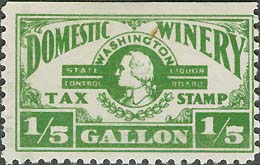On January 23, 1934, Washington Governor Clarence Martin (1887-1955) signs the Steele Liquor Act establishing the Washington State Liquor Control Board. Comprised of three executive members appointed by the governor for nine-, six-, or three-year terms, the board is charged with controlling public access to alcohol by restraining competition. This is accomplished by regulating the legal manufacture and distribution of alcohol within the state, and by licensing the sale of alcoholic beverages in restaurants and hotels with explicit standards regulating required ratios of food sale to beverage sale.
First Acts
The first members of the Washington State Liquor Board were Luther Gregory (1872-1960), a retired rear admiral in the United States Navy who lived in Seattle; William J. Lindberg (1904-1981), former state assistant attorney general and Spokane resident; and Henry Gregerson (1890-1973), a wealthy Battle Ground businessman. Gregory was given the nine-year term, and designated chairman. Lindberg got the six-year term, leaving Gregerson the three-year appointment.
The board's first act was to hire a secretary. It then placed a printing order for license application forms.
Steele Act
In addition to establishing the Washington State Liquor Board, the Steele Act also prohibited businesses from displaying signs or advertising using the words "bar," "barroom," or "saloon." It gave cities and counties (for areas outside city limits) the local option to permit or prohibit public consumption of alcohol -- in other words, to remain dry despite the national and state repeal of Prohibition.
The Steele Act was named for Thurston County Democratic Senator Earl N. Steele (1881-1968), and drafted mainly by former University of Washington law school dean Alfred Schweppe (1895-1988). It was a response to the widespread uncontrolled sale of alcohol that followed the repeal of Prohibition.
Stopping A Spree
Norman Clark's history of Prohibition in Washington describes what he calls the "spree" that followed Prohibition's repeal:
"There was beer available across the street from public schools. Free lunches appeared on the polished mahogany, as did 'whiskey-flavored tonics' with an alcoholic content in excess of 40 per cent. There were taxi dancers, service to minors, and shootings. Roadhouses were wide open, attractive to drunks and to prostitutes. Moonshine booze under fake labels was a standard item in many drug stores. ... It was like an old-fashioned whiskey-fest that even some cynics found depressing" (The Dry Years, p. 241).
Early Regulations
Under the board's earliest regulations, taverns could sell beer (and later wine) by the glass. Hard liquor was not permitted to be consumed in public. The board was empowered to license grocery stores to sell packaged wine and beer, but hard liquor could be sold only through state-owned liquor stores. This purposely created a monopoly, with profits to be divided between the state's general fund and Washington's 39 counties.
The Steele Act empowered the Liquor Control Board to make regulations it deemed advisable. Those regulations carried the same weight as law. Until this power was overruled by the state supreme court in 1965, the rulings of the Liquor Control Board were not subject to executive or judicial review.
The decisions facing the first board were legion. They began immediately to write regulations covering everything from employment requirements at state stores and warehouses; liquor brand selection, pricing, and advertising; food-sales to drink-sales regulations for restaurants; and state purchasing procedures, among many other details. Wading through the thousands of liquor license applications was a prodigious task, and the board was subject to public criticism and second-guessing from individuals, government officials, businesses, and anyone else who chose to weigh in.
Good For State Coffers
By 1936, however, revenues on licensure fees and liquor sales had generated more than $8,600,000 for the state (according to Clark, p. 244), and Washington boasted the lowest prices in the nation on bottled liquor. This greatly discouraged bootlegging.
Governor Martin told the board that the Steele Act was intended to support temperance, adding, "Unlike other businesses, you are not expected to promote sales. Instead of promoting the sale of liquor, your function is only to make good liquor available to people under proper conditions" (quoted in Clark, p. 243). The act's language deemed that its purpose was "for the protection of the welfare, health, peace, morals, and safety of the people of the state" (Sessions Laws... p. 173).
Voice of the People
In 2010, Washington voters faced heavy lobbying to end the state's monopoly on liquor sales. Initiative 1105 would have closed all state liquor stores and licensed private businesses to sell and distribute liquor.
Initiative 1100 did the same, and based license fees on volume sold. On November 2, 2010, Washington voters rejected Initiatives 1100 and 1105.

